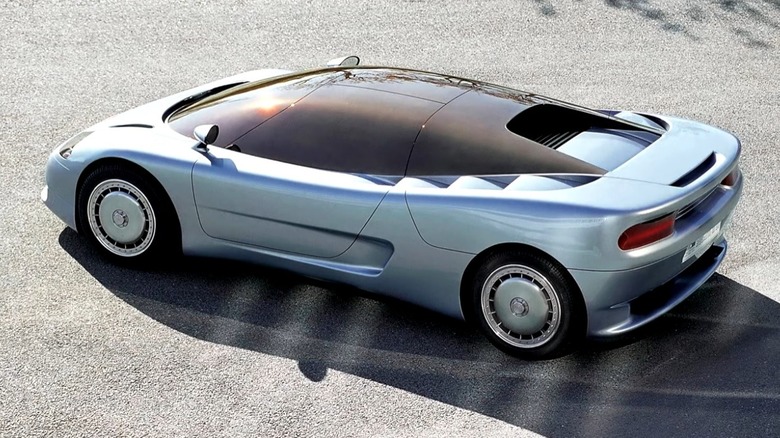6 Bugatti Concept Cars Everyone Forgot About
Ettore Bugatti was born in 1881 in Milan, Italy, and by 1901 was designing racecars and displayed his first automobile (the Type 2) at a show in Milan. Eight years later (1909), he opened an auto manufacturing plant where he created and sold five cars by the end of the year. The company went on to produce many famous vehicles, like the Type 41 Royale in 1926 (one of the most expensive pre-war cars ever sold).
Still, when the Great Depression hit the United States in 1929, the world's economy tanked with it — and so did Bugatti. It struggled through the '30s and '40s, helped by making railcars for the French government, but the car-making aspect of the company eventually faded out not long after Ettore died in 1947.
By the 1980s, the company had moved on to making airplane parts, something many European companies had done (BMW and Saab, for example). An Italian entrepreneur purchased Bugatti in 1987 wanting to revitalize its once proud automobile heritage.
In 1998, the Volkswagen Group went about snatching up car companies like they were Pokémon. Aside from bringing Bentley and Lamborghini into the fold, they also managed to wrangle French luxury sports car manufacturer Bugatti. It maintained ownership until 2021, when it was sold to a joint venture between the Rimac Group and Porsche AG, forming Bugatti Rimac.
Like every automobile company, Bugatti has created several one-off concept cars, some that the public has forgotten or never even knew about.
Vision Gran Turismo
Bugatti unveiled their follow-up supercar not long after the 450th (and last) Veyron was sold in 2015. No, not its other fast and rare hypercar, the Chiron, which wouldn't be shown off until 2016. We're talking about the Vision Gran Turismo. If that name rings a bell, it should because it's considered by many to be the most successful racing simulation game franchise on the planet.
The French company knew this and went all in to create a project for its legion of fans — gamers and car enthusiasts — who might otherwise never get a chance to see, let alone drive, a Bugatti in real life. And we're not talking about making just a "fantasy product," as Achim Anscheidt, head of the Bugatti design team, put it. They aimed to create an authentic, real-world racer that could zip around an actual track.
Bugatti developed the Vision GT with the help of Polyphony Digital Inc. (makers of the game) as a tribute to its Le Mans victories from the 1920s and '30s, specifically the Type 57 G Tank, but with a whole lot of modern flair, much of which made it's way into the real world Chiron.
For instance, it's powered by the same base engine found in the Chiron but tuned to produce 1,650 hp and 1,165.35 ft-lb of torque to all four wheels, which are fitted with a set of custom Michelin racing slicks (costing $93,000). Although the car never raced, Bugatti engineers estimate the Vision can top out at 278 mph.
Type 57 Aérolithe
Bugatti first showed off its prototype Aérolithe Compétition Coupé in 1935. It was built around its popular Type 57 chassis, which went into production the year before. It was meant solely as a study on design, with its sweeping lines and body made from magnesium, and would go on to inspire the Atlantic line.
Jean Bugatti, son of founder Ettore, created the "dorsal-seamed" show car out of a magnesium and aluminum alloy called Elektron. Magnesium was about a third as heavy as aluminum, making the car much lighter. However, welding it together would cause it to catch fire due to its low melting point (approximately 1,150 degrees Fahrenheit). So, it had to be built in sections and riveted together along dorsal seams. One ran the length of the vehicle from front to back, while others ran along both the front and rear fenders.
The visual appeal of the rivets somehow worked perfectly, and that aesthetic was carried on throughout the rest of the car. Combined with the fender skirts (or spats) over the rear wheels, the long hood line (housing a 3.3-liter V8), the oddly shaped suicide doors reminiscent of an airplane, swooping front fenders, and tear drop tail, all made it look like it could fly.
The singular prototype mysteriously disappeared about 10 months after it was unveiled. Some sources say it was destroyed during World War II, while others say it was scrapped for parts. The Guild of Automotive Restorers built an exacting replica using original Bugatti parts and a handful of photos (see the above video).
Galibier 16C
Bugatti showed off the prototype for the 16C Galibier at a private soiree in Molsheim, France, in 2009. According to chief stylist Achim Anscheidt, the company wanted the Galibier to replace the Veyron when that line ended. Alas, that didn't happen.
Looking closely at the front, you can see some of the Veyron's lineage. But the long hood and hint of a dorsal seam running the length of the car to the modest tear drop tail looks very much like a nod to the Aérolithe and Atlantic. It even had the Veyron's engine — a twin-supercharged 8.0-liter W-16 capable of 1,000 hp and a reported 250 mph top speed. What made it different was its ability to run on ethanol, making it a flex-fuel engine.
The Galibier's body was handmade using dark blue carbon fiber pieces that shimmered when bathed in light. While the car's hood and backside were made from rigid yet lightweight carbon fiber, the front fenders and doors were fabricated in polished aluminum.
Additionally, the four-door coupe had four-wheel drive and an entirely new suspension that would have combined to make it the fastest, most potent, and agile sedan on the market ... if only Bugatti had made it.
This prototype is particularly special because, at the time, Volkswagen owned Bugatti. The executives from that group wanted drastic changes made, including making it 60 inches longer and 6 inches taller, which abandoned the original concept of a "sporty, elegantly-tailored sedan." Thus, the company shifted to its backup plan — the Chiron.
Type 73C
Remember, Bugatti has a long and storied past as a maker of race cars, and as such, the Type 73C was one of those vehicles. During World War II, Ettore Bugatti, designers Noel Domboy and Antoine Pichetto came up with a plan to build an all-alloy 16-valve supercharged 1500cc engine with two camshafts based on a 4.7-liter engine used in the Type 59/50 B race car.
It would have some exciting features, including a detachable head (a first for the company), wet cylinder liners, a four-speed synchromesh transmission, sit low to the ground, and weigh less than 1,322 pounds. The plan was also to build a sports salon version that would be sold to the general public.
The plan was to build 20, and at least 15 French drivers are known to have placed a deposit of 25,000 francs (the total cost for each was 500,000 francs). Yet, only five finished sets of parts for the race version and two chassis for the salon were made — not assembled — before Ettore passed away in August 1947.
At the Paris Motor Show later that same year, Bugatti mustered up a hodgepodge display that showed off a chassis and a few race engines. The entire project fell apart after his death; all deposits were returned, and the remaining parts and pieces were stored away. The Type 73C goes down as Ettore's final race car design.
ID 90
The ID 90 appeared at the 63rd Turin Motor Show. It was the first Bugatti designed by Giorgetto Giugiaro, who many consider to be one of — if not the most influential designers of the modern automotive era. This two-seat coupé was based on technical drawings from Bugatti mechanics.
It sported a tweaked powertrain from the EB 110 — a 3.5-liter V12 mid-mounted engine with not one, but four turbochargers, producing 455 hp and a top speed of 174 mph.
The prototype featured an all-wheel drive, a carbon fiber chassis, and a low-slung aluminum body that was just 13.5 feet long and only 6 feet wide. It had some styling similarities to the production model EB 110, including the special alloy rims, which were a direct nod to Bugatti's 1926 Royale.
The glass canopy dome stretches across most of the body, and from the top is the car's most eye-catching design feature. The glass tapers at the back to accommodate a plethora of air intakes needed to cool down the mid-engine behind the seats. At the same time, the overall curve was supposed to elicit a balanced look between a sporty vehicle and a saloon.
Veyron Barchetta
This Veyron concept was, for some time, a secret. A prototype was never actually built, but it's so audacious that it needs to be on this list. Back in 2008, Achim Anscheidt (who became Bugatti's Design Director in 2004) created this low-slung open-cockpit speedster that had no roof and no real windows to speak of. It's a fad that was several years ahead of its time.
Instead, it was designed with a minimal wrap-around windscreen reminiscent of those found on a boat, which makes sense because the Italian word barchetta means "little boat." This Barchetta was based on the Veyron 16.4 Grand Sport Vitesse, the roadster Targa-topped version of the Super Sport, and in all likelihood would have been powered by the same quad-turbo 8.0-liter unusually designed W-16 kicking out 1,200 horsepower.
If it had gone into "full" production, it would have been very limited and equally costly. The base price for the Grand Sport Vitesse was around $2.5 million. Even though Lamborghini was successfully making one-offs and ultra-limited edition cars, the execs at Bugatti couldn't pull the trigger on that kind of business model, so the Barchetta was never made.




